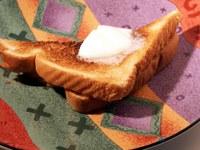Prairie Fare: Here’s How to Avoid Trans Fat in Your Diet
(Click the image below to view a high-resolution image that can be downloaded)
By Julie Garden-Robinson, Food and Nutrition Specialist
NDSU Extension Service
As I prepared for holiday baking, I perused some old cookbooks. My collection ranges from reprints of Civil War-era cookbooks to community-based cookbooks to brand-new cookbooks. Flipping through the pages was like exploring the history of fat use in home cooking and baking.
Most of the old recipes called for home-rendered lard or bacon grease as the fat source. Other recipes called for home-churned butter, margarine (or “oleo”) or “solid shortening” (such as Crisco). Some of the recent recipes used oil in place of all solid fat.
I reflected back on my college years as I read the recipes. One of the first papers I wrote as an undergraduate student majoring in nutrition focused on trans fats. Trans fats are formed during the process of hydrogenation, which converts liquid oil to solid fats. The word “trans” refers to the chemistry of the fat.
The hydrogenation process produces shortening and margarine that are used in baked goods or spreads at the dinner table.
At the time of my undergraduate studies, most people in the health field were advocating the use of stick margarine in place of butter at the dinner table and in baked goods. Not only was margarine less expensive, it also was considered healthier. Hydrogenation also extended the shelf life of the fat.
My college paper was kind of controversial because I included a journal article that questioned the health effects of trans fat. I think I titled my paper “Is butter better?” I was happy to find an article that questioned whether margarine was really good for us because I always preferred the flavor of butter over margarine.
Flash forward many years and now we have an abundance of evidence that trans fat is a type of fat that we want to eliminate from our diets. In fact, trans fat is on the “chopping block” in the food world. The Food and Drug Administration plans to ban this harmful fat from the food supply.
Trans fat can raise your bad (LDL) cholesterol levels and lower your good (HDL) cholesterol levels. LDL deposits cholesterol in the walls of the blood vessels. Higher LDL levels put you at greater risk for a heart attack from a sudden blood clot in an artery.
You need to be somewhat of a detective to find trans fat. Most of us have seen foods that claim to contain no trans fat. Technically, if a food has less than 0.5 gram of trans fat, the food can be labeled “zero grams trans fat.”
Check out the ingredient statement and look for “hydrogenated” to determine if there may be some trans fat lurking in the food.
How can you make your solid fat-containing recipes healthier? In some cases, such as many brownie and quick-bread recipes, you can substitute applesauce for half or more of the solid fat.
If you like to experiment, you can try substituting liquid oil and a prescribed amount of water for the solid fat in your recipes. Butter is about 80 percent fat and 20 percent water. In many recipes, you can substitute 3/4 cup of canola oil and 1/4 cup of water for 1 cup of butter. Margarine varies in the amount of water it contains.
However, you may want to save time by finding a recipe that was formulated to use oil. If you prefer margarine as a spread at the dinner table, remember that the softer, tub-style margarines are much lower in trans fat than stick margarine.
What about butter? Butter contains saturated fat, which current evidence suggests that we limit in our diet. Enjoy a thin spread of butter on your toast, but remember that any type of fat is a concentrated source of calories.
Here’s a healthful recipe courtesy of the Oregon State University Cooperative Extension Service. The recipe contains oil in place of solid fat.
Pumpkin Breakfast Cookies
1 3/4 c. pureed pumpkin (canned or prepared from a whole pumpkin)
1 1/2 c. brown sugar
2 eggs
1/2 c. canola oil
1 1/2 c. flour
1 1/4 c. whole-wheat flour
1 Tbsp. baking powder
2 tsp. cinnamon
1 tsp. nutmeg
1/2 tsp. salt
1/4 tsp. ground ginger
1 c. raisins or dried cranberries
1 c. walnuts, chopped
Preheat the oven to 400 F. Mix pumpkin, brown sugar, eggs and oil thoroughly. Blend dry ingredients, then add to pumpkin mixture. Add raisins and nuts. Drop by the teaspoonful on a greased cookie sheet. Bake 10 to 12 minutes until golden brown.
Makes 48 cookies. Each cookie has 90 calories, 4 grams (g) of fat, 13 g of carbohydrate, 1 g of fiber, 2 g of protein and 60 milligrams of sodium.
(Julie Garden-Robinson, Ph.D., R.D., L.R.D., is a North Dakota State University Extension Service food and nutrition specialist and professor in the Department of Health, Nutrition and Exercise Sciences.)
NDSU Agriculture Communication – Dec. 19, 2013
| Source: | Julie Garden-Robinson, (701) 231-7187, julie.garden-robinson@ndsu.edu |
|---|---|
| Editor: | Rich Mattern, (701) 231-6136, richard.mattern@ndsu.edu |


